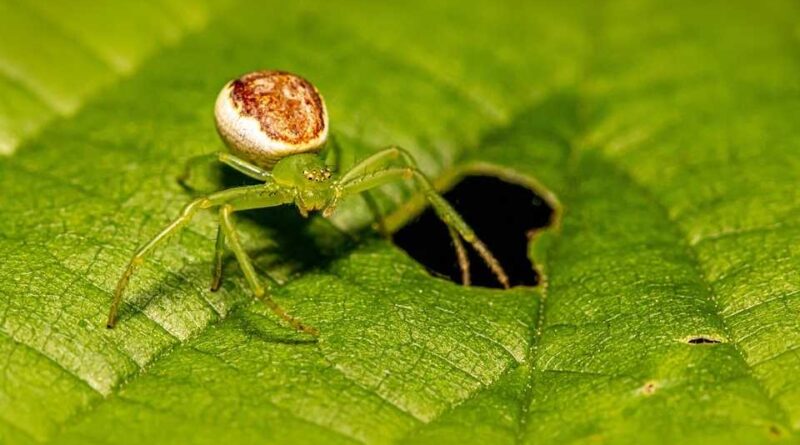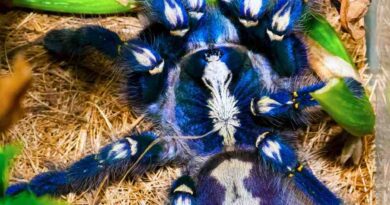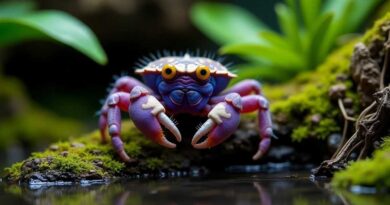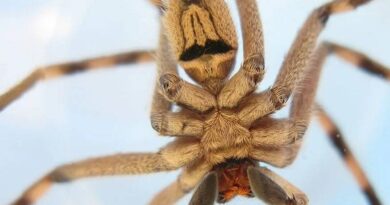How Crab Spiders Master Color-Changing Camouflage: A Scientific Explanation
The crab spider family has more than 2,100 species spread across 170 genera worldwide. Unlike most spiders that spin webs, these incredible creatures excel at ambush hunting. They possess a remarkable trait – they can change their color to match their flower homes.
These natural masters of disguise can alter their appearance gradually over days. They seamlessly blend with wildflowers by switching between white, yellow, and purple hues. Though tiny at just 12mm long, these remarkable arachnids showcase nature’s most impressive camouflage systems. Their color-changing skill serves two purposes: it keeps them hidden from predators and makes them virtually invisible to prey that lands on their flower perches.
This piece will delve into the scientific mechanisms that power crab spider camouflage. We’ll look at how these small but incredible creatures achieve their color-changing prowess and what environmental factors trigger these transformations in the wild.
The Science Behind Crab Spider Color Change
Crab spiders change color through a sophisticated interplay of pigments, crystals, and cellular processes. These remarkable creatures use a complex physiological system with specialized cells and chemical compounds to change their colors [1].
Molecular Mechanisms of Pigment Production
Specialized cells called guanocytes and the endolysosomal system work together to handle pigment-light interactions that enable color changes [2]. These pigment organelles are part of the lysosome-related organelle family, like in vertebrate melanosomes [2]. The spider’s distinctive coloration comes from intraluminal vesicles and metal deposits working in harmony.
Role of in White Coloration Guanine Crystals
Crab spider’s white coloration comes from guanine crystals that exist in storage cells beneath the hypodermis [3]. These crystals have unique properties:
- Reflect UV light through a partially UV-transmitting hypodermis
- Create matte-white appearance through cuboid crystal structures
- Serve as a background canvas for other pigments
Yellow Pigment Synthesis Pathways
Yellow coloration emerges through a complex biochemical pathway. The compounds that create yellow pigmentation include 3-hydroxy-kynurenine, xanthommatin, and ommatin D [1]. The change from white to yellow happens as these ommochrome pigments form, and the reverse occurs when spiders turn from yellow to white [1]. The , while the change to white needs about 6 days yellow coloration process takes 10-25 days[4].
Yellow spiders’ hypodermis contains electron-dense granules that consist of 3-OH-kynurenine. These work with xanthommatin to create the yellow coloration [3]. The presence of decarboxylated xanthommatin hints at new pathways in ommochrome synthesis, though scientists still study their exact roles [1].
Environmental Triggers of Color Adaptation
Background conditions play a vital part in triggering color adaptations among crab spiders. These remarkable arachnids respond to environmental cues that shape their color-changing capabilities.
Light Intensity Effects
Natural illumination drives the color adaptation process in crab spiders. Adult females display a high when they reflect light in the ultraviolet wavelength range mean UV spectral reflectance of 16.02%[5]. Natural light is different from laboratory conditions and proves much stronger than artificial light. This greatly affects the spider’s color-changing process [6].
Crab spiders show remarkable abilities to match their backgrounds through both chromatic and achromatic contrasts during field observations. These spiders achieve systematic crypsis through achromatic contrast at longer distances [7]. This adaptation helps them stay hidden from potential prey, since flower-visiting insects avoid areas within 90mm of visible crab spiders [8].
Temperature Impact on Change Rate
Temperature greatly influences how fast crab spiders change their colors. The , while changing from yellow to white happens faster and takes only 2-6 days transition from white to yellow needs 10-25 days[9]. The speed of changing from whitish to yellow is 1.43 times faster than turning white [10].
Environmental factors create interesting variations in the color adaptation process. Spiders that molt change from yellow to white more slowly compared to non-molting ones [10]. The background color acts as a major trigger for color change, especially in direct sunlight. These spiders adapt their colors to match their chosen backgrounds as time passes [10].
Color-Changing Process Timeline
The color change experience of crab spiders follows a precise timeline that shows distinct phases of pigment changes and behavioral adaptations. These spiders start their color transformation after settling on a yellow flower within 24 hours[11].
Original Color Assessment Phase
The spider’s body goes through an assessment period where visible changes appear during the first day. The spider’s cellular machinery activates and focuses on producing ommochrome pigments [12]. The spider’s epidermis shows its first yellow tints by day one [11].
Gradual Pigment Transformation
Color changes become more intense between days 3-8, and some spiders achieve substantial changes by day 3 [11]. White specimens change color when turning yellow compared to the reverse process 2.14 times faster[10]. This speed difference points to varying metabolic costs for different color transformations.
Final Color Stabilization Period
A white-to-yellow transformation needs 10-25 days to stabilize completely [9]. The yellow-to-white process happens faster and takes about 5-6 days [9]. The final phase includes:
- White to yellow: Complete transformation in 10-25 days [9]
- Yellow to white: Stabilization within 5-6 days [9]
- Color maintenance: Continuous pigment regulation [12]
Several factors affect these timeline variations, including the spider’s starting color and environmental conditions. Yellow females ended up showing distinct behavior patterns. They often abandon white flowers instead of going through the more demanding yellow-to-white transformation [12].
Species-Specific Color Change Abilities
Crab spider species have evolved unique color-changing abilities that match their hunting strategies and habitats. Each species uses specialized pigment mechanisms to adapt to their environment.
Flower Crab Spider’s White-Yellow Changes
The flower crab spider (Misumena vatia) can change its color between white and yellow shades [12]. These spiders show clear priorities in their habitat choice – yellow spiders pick only yellow flowers. All the same, white spiders can adapt to both yellow and white flowers [13]. The spider’s color-changing process works like this:
- A white to yellow change takes 10-25 days[14]
- Yellow turns back to white in 6 days [14]
- Visual signals trigger color changes [14]
- The spider adapts to pink or pale green colors too [14]
Japanese Crab Spider’s Color Range
The Japanese spider crab (Macrocheira kaempferi) has a different approach with its fixed colors that range from dark orange to light tan [15]. Unlike its color-changing relatives, these crabs use other ways to hide. Their rough shell helps them blend with rocky ocean floors [16]. Young Japanese spider crabs decorate their shells with sponges or kelp to hide better [16].
The crab keeps its shell color unchanged through adulthood [15]. These giants rely on their size and strong claws to stay safe from predators instead of changing colors [16]. Their tough shell measures about 37 centimeters [15], and with extended legs fully grown crabs can stretch up to 4 meters[15].
Short Summary
Crab spiders showcase nature’s brilliance with their remarkable color-changing skills. These small arachnids achieve perfect camouflage on flowers of all types through their complex body systems that use specialized guanocytes and detailed pigment pathways.
Research has uncovered captivating details about these spiders’ transformation process. The spiders need 10-25 days to change from white to yellow, but they can switch back to white much faster – usually within 6 days. Natural light intensity and temperature play crucial roles in these color shifts.
Each species demonstrates this amazing trait differently. The flower crab spider Misumena vatia masterfully switches between white and yellow colors, while its cousin, the Japanese spider crab, uses other tricks to hide.
Nature has refined these spiders’ disguise system over millions of years. Their talent for matching flower colors helps them dodge predators and makes them excellent ambush hunters. Scientists keep discovering new layers of complexity behind these spiders’ color-changing powers, which deepens our knowledge of how creatures adapt in nature.
FAQs
Q1. How do crab spiders change their color?
A1. Crab spiders change color through specialized cells called guanocytes and a complex biochemical process. They can produce yellow pigments like 3-hydroxy-kynurenine and xanthommatin, while white coloration comes from guanine crystals. The transformation from white to yellow typically takes 10-25 days, while changing from yellow to white occurs more rapidly, in about 6 days.
Q2. What triggers color changes in crab spiders?
A2. Color changes in crab spiders are primarily triggered by environmental factors. Natural light intensity plays a crucial role, with spiders reflecting UV light to match their backgrounds. Temperature also affects the rate of color change. Additionally, the background color of the spider’s chosen flower or habitat serves as a major trigger for adaptation.
Q3. How effective is the crab spider’s camouflage?
A3. Crab spider camouflage is highly effective. They can match their background through both chromatic and achromatic contrasts, achieving systematic crypsis at longer distances. This adaptation helps them avoid detection by predators and makes them nearly invisible to unsuspecting prey that land on their chosen flowers.
Q4. Do all crab spider species have the same color-changing abilities?
A4. No, color-changing abilities vary among crab spider species. For example, the flower crab spider (Misumena vatia) can shift between white and yellow shades, and even adapt to pink or pale green hues. In contrast, some species like the Japanese spider crab have fixed coloration patterns and rely on other camouflage strategies.
Q5. How long does it take for a crab spider to complete its color transformation?
A5. The time required for color transformation varies depending on the direction of the change. White crab spiders begin changing color within 24 hours of settling on a yellow flower. The complete transformation from white to yellow typically takes 10-25 days, while the reverse process from yellow to white is faster, taking approximately 5-6 days.
References
[1] – https://link.springer.com/article/10.1007/s10886-010-9765-7
[2] – https://pmc.ncbi.nlm.nih.gov/articles/PMC8536372/
[3] – https://besjournals.onlinelibrary.wiley.com/doi/10.1111/1365-2435.12300
[4] – https://moore.ces.ncsu.edu/2021/05/crabspiders/
[5] – https://pmc.ncbi.nlm.nih.gov/articles/PMC5569008/
[6] – https://journals.biologists.com/jeb/article/216/20/i/11708/CRAB-SPIDERS-TRICKS-FOR-YELLOW-CAMOUFLAGE
[7] – https://journals.biologists.com/jeb/article/213/9/1425/10254/Background-colour-matching-by-a-crab-spider-in-the
[8] – https://www.researchgate.net/publication/270912505_Colour_change_ability_and_its_effect_on_prey_capture_success_in_female_Misumenoides_formosipes_crab_spiders
[9] – https://www.researchgate.net/publication/229838148_Experiments_on_color_changes_and_regeneration_in_the_crab-Spider_Misumena_vatia
[10] – https://journals.biologists.com/jeb/article/216/20/3886/11740/Environmental-and-hormonal-factors-controlling
[11] – https://news.unl.edu/article/doctoral-student-first-to-quantify-color-change-in-spiders
[12] – https://resjournals.onlinelibrary.wiley.com/doi/10.1111/een.12167
[13] – https://journals.biologists.com/jeb/article/208/10/1785/15316/Colouration-in-crab-spiders-substrate-choice-and
[14] – https://en.wikipedia.org/wiki/Misumena_vatia
[15] – https://animaldiversity.org/accounts/Macrocheira_kaempferi/
[16] – https://www.montereybayaquarium.org/animals/animals-a-to-z/japanese-spider-crab



